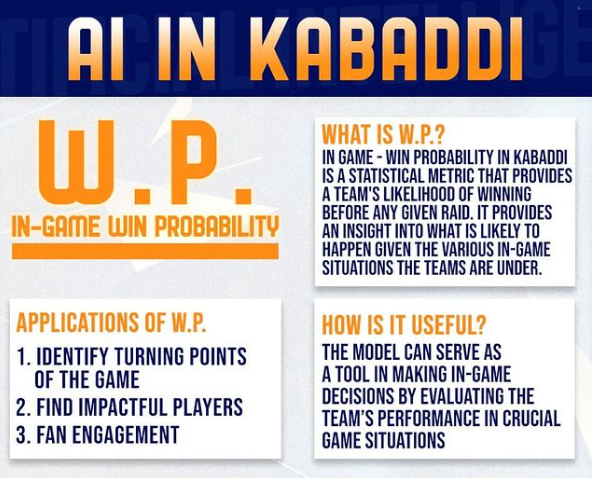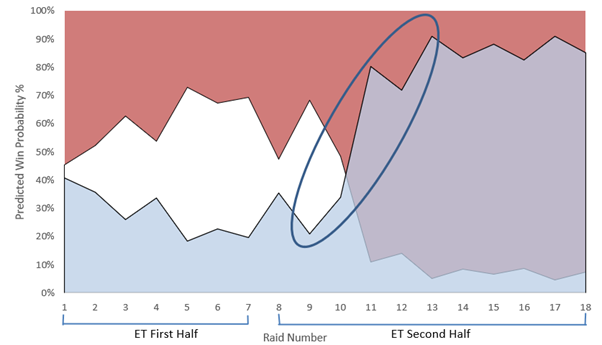Win Probability in Kabaddi
Analyzing PKL Match

A win probability is a likelihood that, given any time-state in the game, a certain team will win the game. It’s not a case of saying this is definitely going to happen, it’s providing an insight into what is likely to happen given the various game situations the teams are under.
Though in-game win-probability models have been extensively studied in baseball, basketball, and American football, very little work has been done in the field of Kabaddi.
Hence we at SportsKPI have built an in-game win probability model for the raiding (attacking) team during a Kabaddi game. In-game win probability in Kabaddi is a statistical metric that provides a team’s likelihood of winning before any given raid. The model can serve as a tool in making in-game decisions by evaluating the team’s performance in crucial game situations, craft strategies, and also fan engagement for broadcasters.
To make this prediction, we train our model using event data from the last three seasons of the Pro Kabaddi League comprising 413 matches and 35356 events(raids). The model is predicted based on various features such as score difference, time remaining, number of raiding and defending team players on the mat at any given raid, how long each team has been rested before the game, and the playing venue.
We elaborate on two important use cases of our win probability metric i.e, identify critical scenarios or turning points in a game that swing the win probability of a game the most and evaluate the overall raider’s impact during a game in terms of aggregated win probability of all their raids.
In the previous Pro Kabaddi 2019 season, we got to witness one of the most thrilling matches where Bengaluru Bulls overturned an 11-point deficit to beat UP Yoddha in Eliminator 1 round. The game was decided in extra-time, the first instance of added time in the history of Pro Kabaddi League.
Let us use the match, Bengaluru Bulls vs UP Yoddha Eliminator 1 as an example to explain the predicted win probabilities of our model before any given raid and also identify the turning points.
One thing to note about our win probability model is we are trying to predict the win probability for an average team, hence as we can see from the above graph, both teams come into 1st Raid with 50% win probability.
As the game went on UP Yoddha was able to tackle Pawan Sehrawat twice in the starting 9 minutes of the game alongside winning an All Out and extending the point difference to as many 11 points which shot their win probability to 91% going into 24th Raid.
But Bengaluru Bulls climbed back up to first 32% before 27th Raid as Pawan Sehrawat scored a super raid, then 33% just before Half Time whistle owing to another 2 Successful raid points from Pawan Sehrawat leading to an All Out.
As soon the 2nd Half of the match kicked off, another 2 Successful Raid points from Pawan Sehrawat shot Bengaluru’s win percentage to 54% turning the match in their favor for the first time and leading by 2 points.
As match progressed Bengaluru Bulls could not hold on to their lead and UP Yoddha were able to successfully tackle Pawan Sehrawat twice keeping him out of the mat for most part of the 2nd Half, which shot their win percentage to as high as 90% and again extending the lead to 8 points before 70th Raid.
With around 5 minutes remaining on the clock, and 90% predicted win percentage from our model, UP Yoddha were clearly in the pole position to finish the match on the winning side.
But you can see from the above graph that UP Yoddha’s win percentage drastically dropped to 35% before the 76th raid. This is one of the biggest drop in the win % (55% drop) as UP Yoddha continuously conceded points in attack as well as defense mainly due to Sumit Singh’s consecutive successful raids breaking UP Yoddha’s rigid 4 & 5 defense which eventually led to an All Out from Pawan Sehrawat yet again.
With the last raid to go, UP Yoddha had a predicted win percentage of 29% as they were trailing by one point and predicted the probability of 18%, and the match finally ended in a draw (36 each points) with UP securing one raid point due to an advanced tackle from Ankit.
UP Yoddha started the first half of extra time comfortably with 2 successful raid points from Rishank and a successful tackle on Rohit Kumar, which shot their win percentage to as high as 69% just before the half time.
Just a minute into the 2nd half of extra time, an advanced tackle from Sumit (UP Yoddha) proved to be the turning point, conceding a super raid to Pawan Sehrawat with 2 minutes to go. As you can see from the above graph, a single raid shot the win percentage of Bengaluru first from 20% to 48%, and then followed by All Out to a massive 91%.
Bengaluru Bulls were sitting at 5 point lead with 1.5 minutes to full time, and strategically planned to not concede more than 1 point in the subsequent raids to win the thrilling game.
As we see here, just a few moments can lead to massive swings in the win probability for teams and knowing about these can play a significant role when it comes to in-game decision making for coaches.
As always, do reach out to us regarding any feedback or if you want to know more about all things Kabaddi analytics!


